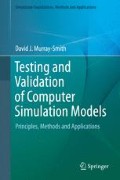Abstract
This case study is concerned with the application of verification and validation techniques to a system involving two interconnected tanks of liquid. This involves bench-top equipment used in a teaching laboratory. Key variables of the system are easily accessible for measurements and the application of test input signals is straightforward. The model of the system is presented in full and tests for estimation of some unknown parameters are discussed. Internal verification of the simulation is considered in terms of checking of code or block diagram interconnections, algorithmic checks and also comparisons of simulation results with analytical solutions for steady-state situations. The process of validation is then addressed using graphical methods, techniques based on the use of model distortion, a Genetic Programming method of system identification and the application of inverse simulation. Possible improvements to the basic model are then discussed in the final section of the chapter.
Access this chapter
Tax calculation will be finalised at checkout
Purchases are for personal use only
References
Wellstead PE (1981) Coupled tanks apparatus, manual. TecQuipment Ltd., Nottingham
Gong M, Murray-Smith DJ (1998) A practical exercise in simulation model validation. Math Comput Model Dyn Syst 4(1):100–117
Murray-Smith DJ (2012) An application of the individual channel analysis and design approach to control of a two-input two-output coupled-tanks system. Acta Polytech 52(4):121–134
Gray GJ, Lew KV, Murray-Smith DJ (1997) Applications of the distortion method for model validation. In: Troch I, Breitenecker F (eds) Proceedings 2nd MATHMOD VIENNA IMACS symposium on mathematical modelling, February 1997. Argesim, Vienna, pp 1033–1038
Gray GJ, Murray-Smith DJ, Li Y et al (1998) Nonlinear model structure identification using genetic programming. Control Eng Pract 6:1341–1352
Murray-Smith DJ, Wong BO (1997) Inverse simulation techniques applied to the external validation of nonlinear dynamic models. In: Luker P (ed) UKSim’97, third conference of the United Kingdom simulation society, Keswick, April 1997. UKSim, Edinburgh, pp 100–104
Author information
Authors and Affiliations
Rights and permissions
Copyright information
© 2015 Springer International Publishing Switzerland
About this chapter
Cite this chapter
Murray-Smith, D.J. (2015). Case Study: Development and Testing of a Simulation Model of Two Interconnected Vessels. In: Testing and Validation of Computer Simulation Models. Simulation Foundations, Methods and Applications. Springer, Cham. https://doi.org/10.1007/978-3-319-15099-4_9
Download citation
DOI: https://doi.org/10.1007/978-3-319-15099-4_9
Publisher Name: Springer, Cham
Print ISBN: 978-3-319-15098-7
Online ISBN: 978-3-319-15099-4
eBook Packages: Computer ScienceComputer Science (R0)

